RabbitMQ-TTL-死信队列_DLX
1. 简介
死信队列,简称:DLX,Dead Letter Exchange(死信交换机),当消息成为Dead message后,可以被重新发送到另外一个交换机,这个交换机就是DLX。
(一般会将DLX和与其binding 的 Queue,一并称为死信队列或DLX,习惯而已,不必纠结)

那么什么情况下会成为Dead message?
- 队列的长度达到阈值。
- 消费者拒接消费消息,
basicNack/basicReject,并且不把消息重新放入原目标队列,requeue=false。 - 原队列存在消息过期设置,消息到达超时时间未被消费。
流程讲解,如图所示(以第三种情况为例):
Producer发送一条消息到Exchange并路由到设有过期时间(假设30分钟)的Queue中。- 当消息的存活时间超过了30分钟后,
Queue会将消息转发给DLX。 DLX接收到Dead message后,将Dead message路由到与其绑定的Queue中。- 此时消费者监听此死信队列并消费此消息。
死信队列有什么用呢?
- 取消订单(比如下单30分钟后未付款,则取消订单,回滚库存),或者新用户注册,隔段时间进行短信问候等。
- 将消费者拒绝的消息发送到死信队列,然后将消息进行持久化,后续可以做业务分析或者处理。
2. TTL
因为要实现延迟消息,我们先得知道如何设置过期时间。这里指演示
TTL :Time To Live(存活时间/过期时间),当消息到达存活时间后,还没有被消费,会被自动清除。
RabbitMQ可以对消息设置过期时间,也可以对整个队列(Queue)设置过期时间。
设置队列过期时间使用参数:x-message-ttl,单位:ms(毫秒),会对整个队列消息统一过期。
设置消息过期时间使用参数:expiration。单位:ms(毫秒),当该消息在队列头部时(消费时),会单独判断这一消息是否过期。
如果两者都进行了设置,以时间短的为准。
2.1 队列设置TTL
2.1.1 引入所需依赖
<dependency>
<groupId>org.springframework.boot</groupId>
<artifactId>spring-boot-starter-amqp</artifactId>
</dependency>
<dependency>
<groupId>org.projectlombok</groupId>
<artifactId>lombok</artifactId>
<optional>true</optional>
</dependency>
<dependency>
<groupId>org.springframework.boot</groupId>
<artifactId>spring-boot-starter-test</artifactId>
<scope>test</scope>
</dependency>
<dependency>
<groupId>org.springframework.amqp</groupId>
<artifactId>spring-rabbit-test</artifactId>
<scope>test</scope>
</dependency>
2.1.2 application.yaml
spring:
rabbitmq:
host: localhost
port: 5672
# rabbit 默认的虚拟主机
virtual-host: /
# rabbit 用户名密码
username: admin
password: admin123
2.1.3 RabbitConfig
- 声明一个过期时间为30s的
Queue。 - 声明一个交换机(这里声明的是主题交换机,交换机类型无所谓,只要消息能路由到
Queue即可)。 - 设置绑定关系。
import org.springframework.amqp.core.Binding;
import org.springframework.amqp.core.BindingBuilder;
import org.springframework.amqp.core.Exchange;
import org.springframework.amqp.core.ExchangeBuilder;
import org.springframework.amqp.core.Queue;
import org.springframework.amqp.core.QueueBuilder;
import org.springframework.beans.factory.annotation.Qualifier;
import org.springframework.context.annotation.Bean;
import org.springframework.context.annotation.Configuration;
/**
* 设置过期队列
*
* @author ludangxin
* @date 2021/9/15
*/
@Configuration
public class RabbitTtlConfig {
public static final String EXCHANGE_NAME = "TTL_EXCHANGE";
public static final String QUEUE_NAME = "TTL_QUEUE";
@Bean(QUEUE_NAME)
public Queue queue() {
return QueueBuilder.durable(QUEUE_NAME).ttl(30000).build();
}
@Bean(EXCHANGE_NAME)
public Exchange exchange() {
return ExchangeBuilder.topicExchange(EXCHANGE_NAME).durable(true).build();
}
@Bean
public Binding binding(@Qualifier(QUEUE_NAME) Queue queue, @Qualifier(EXCHANGE_NAME) Exchange exchange) {
return BindingBuilder.bind(queue).to(exchange).with("ttl.#").noargs();
}
}
2.1.4 Producer
import com.ldx.rabbitmq.config.RabbitTtlConfig;
import org.springframework.amqp.rabbit.core.RabbitTemplate;
import org.springframework.beans.factory.annotation.Autowired;
import org.springframework.stereotype.Component;
/**
* 具有过期时间的消息 生产者
*
* @author ludangxin
* @date 2021/9/9
*/
@Component
public class TtlProducer {
@Autowired
private RabbitTemplate rabbitTemplate;
public void sendMsg() {
rabbitTemplate.convertAndSend(RabbitTtlConfig.EXCHANGE_NAME, "ttl.user", "这是一条有生命周期的消息。");
}
}
2.1.5 测试代码
@Autowired
private TtlProducer ttlProducer;
@Test
public void sendMsg() {
ttlProducer.sendMsg();
}
2.1.6 启动测试
运行测试代码后,到RabbitMQ 控制台中查看队列即消息情况。
如图所示,消息存活30s未被消费后,消息被遗弃。
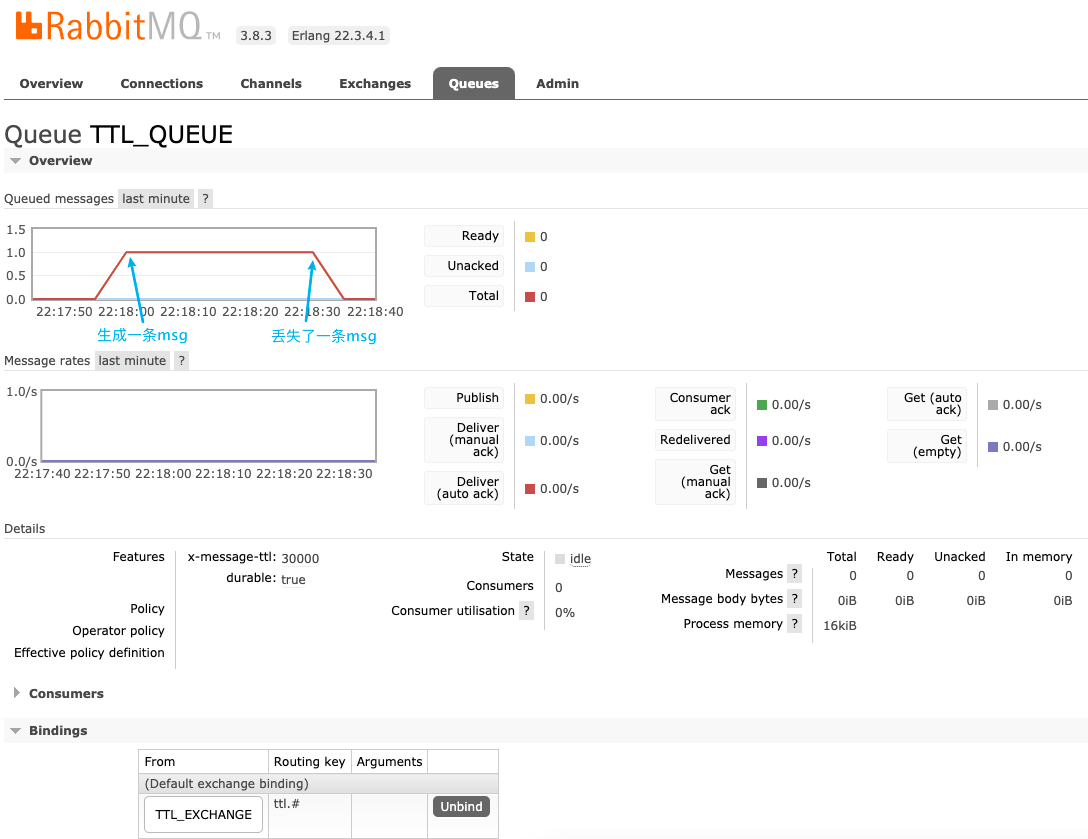
2.2 消息设置TTL
2.2.1 Producer
我们将Producer代码稍加修改,给消息设置10s的过期时间,观察消息到底是存活30s还是10s。
import com.ldx.rabbitmq.config.RabbitTtlConfig;
import org.springframework.amqp.core.Message;
import org.springframework.amqp.core.MessageProperties;
import org.springframework.amqp.rabbit.core.RabbitTemplate;
import org.springframework.beans.factory.annotation.Autowired;
import org.springframework.stereotype.Component;
/**
* 具有过期时间的消息 生产者
*
* @author ludangxin
* @date 2021/9/9
*/
@Component
public class TtlProducer {
@Autowired
private RabbitTemplate rabbitTemplate;
public void sendMsg() {
MessageProperties mp = new MessageProperties();
mp.setExpiration("10000");
Message message = new Message("这是一条有生命周期的消息。".getBytes(), mp);
rabbitTemplate.convertAndSend(RabbitTtlConfig.EXCHANGE_NAME, "ttl.user", message);
}
}
2.2.2 启动测试
如图所示,消息只存活了10s。
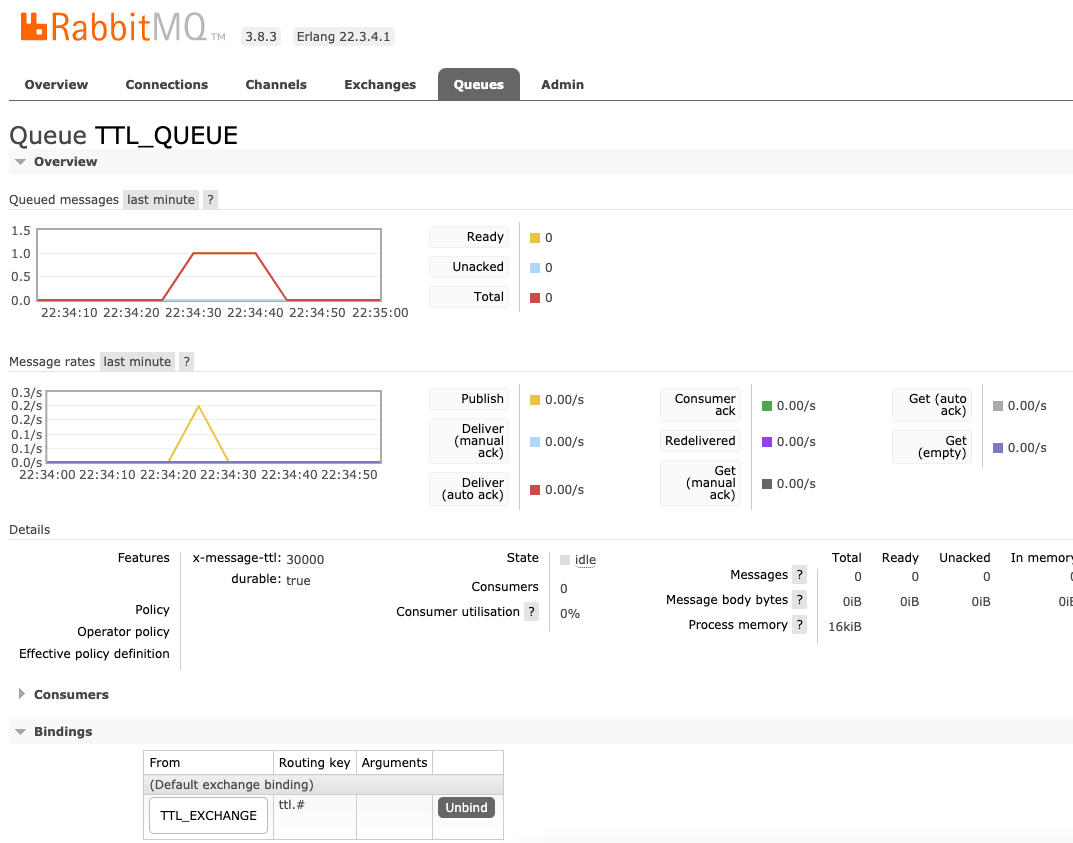
我们将过期时间设置成40s后,但消息还是只存活了30s。说明当同时设置了过期时间时,是以时间短的为准。
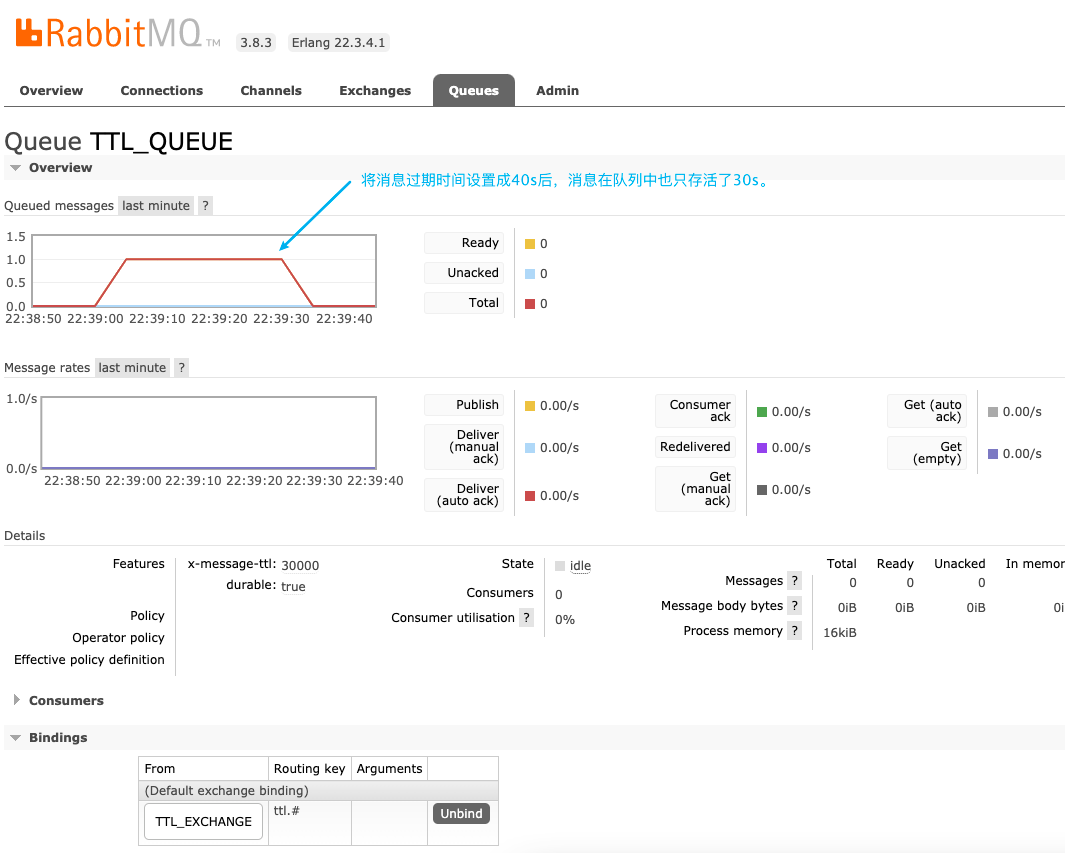
3. TTL + DLX
接下来我们通过设置过期时间和死信队列来实现延迟队列的功能。
首先罗列下实现步骤:
- 声明一个
Exchange与TTl Queue,并且绑定关系,实现生成死信的逻辑。 - 声明一个
DLX与Queue,此步骤的Queue是为了接收死信并让Consumer进行监听消费的。 - 将
TTl Queue与DLX进行绑定,使消息成为死信后能转发给DLX。
3.1 RabbitConfig
其实DLX与普通的Exchange没有什么区别,只不过是“生产”死信的Queue指定了消息成为死信后转发到DLX。
import org.springframework.amqp.core.Binding;
import org.springframework.amqp.core.BindingBuilder;
import org.springframework.amqp.core.Exchange;
import org.springframework.amqp.core.ExchangeBuilder;
import org.springframework.amqp.core.Queue;
import org.springframework.amqp.core.QueueBuilder;
import org.springframework.beans.factory.annotation.Qualifier;
import org.springframework.context.annotation.Bean;
import org.springframework.context.annotation.Configuration;
/**
* 死信队列配置
*
* @author ludangxin
* @date 2021/9/15
*/
@Configuration
public class RabbitDeadLetterConfig {
public static final String QUEUE_NAME_TTL = "QUEUE_NAME_TTL_1";
public static final String EXCHANGE_NAME_TTL = "EXCHANGE_NAME_TTL_1";
public static final String QUEUE_NAME_DEAD_LETTER = "QUEUE_NAME_DEAD_LETTER";
public static final String EXCHANGE_NAME_DLX = "EXCHANGE_NAME_DLX";
public static final String ROUTING_KEY_DLX = "EXPIRE.#";
public static final String ROUTING_KEY_DEAD_LETTER = "EXPIRE.10";
public static final String ROUTING_KEY_TTL = "EXPIRE_TTL_10";
/**
* 1. Queue 队列
*/
@Bean(QUEUE_NAME_TTL)
public Queue queue() {
/*
* 1. 设置队列的过期时间 30s
* 2. 绑定DLX
* 3. 设置routing key(注意:这里设置的是路由到死信Queue的路由,并不是设置binding关系的路由)
*/
return QueueBuilder.durable(QUEUE_NAME_TTL).ttl(10000).deadLetterExchange(EXCHANGE_NAME_DLX).deadLetterRoutingKey(ROUTING_KEY_DEAD_LETTER).build();
}
/**
* 2. exchange
*/
@Bean(EXCHANGE_NAME_TTL)
public Exchange exchange() {
return ExchangeBuilder.directExchange(EXCHANGE_NAME_TTL).durable(true).build();
}
/**
* 3. 队列和交互机绑定关系 Binding
*/
@Bean
public Binding bindExchange(@Qualifier(QUEUE_NAME_TTL) Queue queue, @Qualifier(EXCHANGE_NAME_TTL) Exchange exchange) {
return BindingBuilder.bind(queue).to(exchange).with(ROUTING_KEY_TTL).noargs();
}
/**
* 4. 死信队列
*/
@Bean(QUEUE_NAME_DEAD_LETTER)
public Queue deadLetterQueue() {
return QueueBuilder.durable(QUEUE_NAME_DEAD_LETTER).build();
}
/**
* 5. dlx
*/
@Bean(EXCHANGE_NAME_DLX)
public Exchange exchangeDlx() {
return ExchangeBuilder.topicExchange(EXCHANGE_NAME_DLX).durable(true).build();
}
/**
* 6. 队列和交互机绑定关系 Binding
*/
@Bean
public Binding bindDlxExchange(@Qualifier(QUEUE_NAME_DEAD_LETTER) Queue queue, @Qualifier(EXCHANGE_NAME_DLX) Exchange exchange) {
return BindingBuilder.bind(queue).to(exchange).with(ROUTING_KEY_DLX).noargs();
}
}
3.2 Producer
import com.ldx.rabbitmq.config.RabbitDeadLetterConfig;
import org.springframework.amqp.core.Message;
import org.springframework.amqp.rabbit.core.RabbitTemplate;
import org.springframework.beans.factory.annotation.Autowired;
import org.springframework.stereotype.Component;
import java.time.LocalDateTime;
import java.time.format.DateTimeFormatter;
/**
* 延迟消息生产者
*
* @author ludangxin
* @date 2021/9/9
*/
@Component
public class DelayProducer {
@Autowired
private RabbitTemplate rabbitTemplate;
public void sendMsg() {
String msg = "这是一条有生命周期的消息,发送时间为:" + LocalDateTime.now().format(DateTimeFormatter.ofPattern("yyyy-MM-dd HH:mm:ss"));
Message message = new Message(msg.getBytes());
rabbitTemplate.convertAndSend(RabbitDeadLetterConfig.EXCHANGE_NAME_TTL, RabbitDeadLetterConfig.ROUTING_KEY_TTL, message);
}
}
3.3 Consumer
import com.ldx.rabbitmq.config.RabbitDeadLetterConfig;
import lombok.extern.slf4j.Slf4j;
import org.springframework.amqp.core.Message;
import org.springframework.amqp.rabbit.annotation.RabbitListener;
import org.springframework.stereotype.Component;
import java.time.LocalDateTime;
import java.time.format.DateTimeFormatter;
/**
* 延迟消息消费者
*
* @author ludangxin
* @date 2021/9/9
*/
@Slf4j
@Component
public class DelayConsumer {
@RabbitListener(queues = {RabbitDeadLetterConfig.QUEUE_NAME_DEAD_LETTER})
public void dlxQueue(Message message){
log.info(new String(message.getBody()) + ",消息接收时间为:" + LocalDateTime.now().format(DateTimeFormatter.ofPattern("yyyy-MM-dd HH:mm:ss")));
}
}
3.4 测试代码
@Autowired
private DelayProducer delayProducer;
@Test
@SneakyThrows
public void sendDlxMsg() {
delayProducer.sendMsg();
// 使进程阻塞,方便Consumer监听输出Message
System.in.read();
}
3.5 启动测试
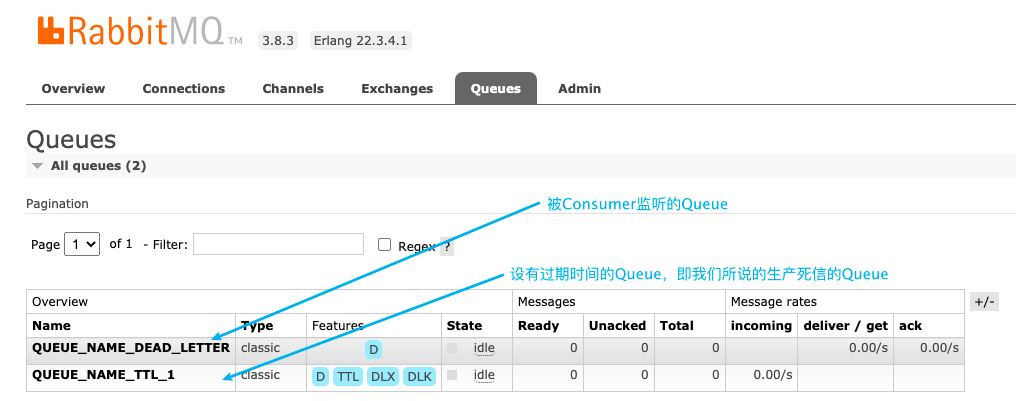
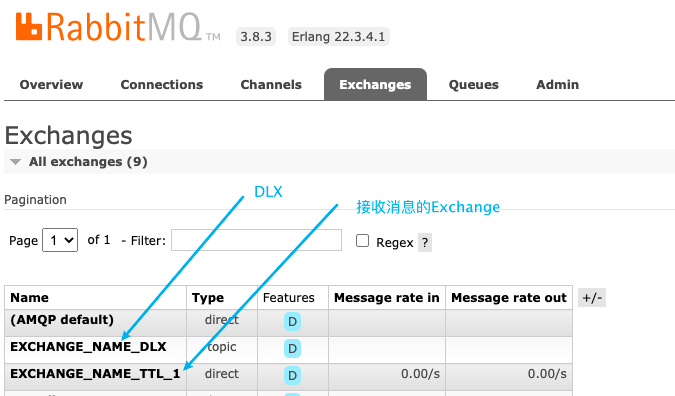
输出日志内容如下:
2021-09-15 23:51:22.795 INFO 8122 --- [ntContainer#0-1] com.ldx.rabbitmq.consumer.DelayConsumer : 这是一条有生命周期的消息,发送时间为:2021-09-15 23:51:12,消息接收时间为:2021-09-15 23:51:22
RabbitMQ-TTL-死信队列_DLX的更多相关文章
- RabbitMQ实战-死信队列
RabbitMQ死信队列 场景说明 代码实现 简单的Util 生产者 消费者 场景说明 场景: 当队列的消息未正常被消费时,如何解决? 消息被拒绝并且不再重新投递 消息超过有效期 队列超载 方案: 未 ...
- RabbitMQ配置死信队列
死信队列 消息传输过程中难免会产生一些无法及时处理的消息,这些暂时无法处理的消息有时候也是需要被保留下来的,于是这些无法被及时处理的消息就变成了死信. 既然需要保留这些死信,那么就需要一个容器来存储它 ...
- RabbitMQ之死信队列
1:何为死信队列 死信队列也是一个正常的队列,可以被消费. 但是,死信队列的消息来源于其他队列的转发. 2:如何触发死信队列 1:消息超时 2:队列长度达到极限 3:消息被拒绝消费,并不再重进队列,且 ...
- RabbitMQ 消费端限流、TTL、死信队列
目录 消费端限流 1. 为什么要对消费端限流 2.限流的 api 讲解 3.如何对消费端进行限流 TTL 1.消息的 TTL 2.队列的 TTL 死信队列 实现死信队列步骤 总结 消费端限流 1. 为 ...
- 【RabbitMQ】一文带你搞定RabbitMQ死信队列
本文口味:爆炒鱿鱼 预计阅读:15分钟 一.说明 RabbitMQ是流行的开源消息队列系统,使用erlang语言开发,由于其社区活跃度高,维护更新较快,性能稳定,深得很多企业的欢心(当然,也包括我 ...
- 面试官:RabbitMQ过期时间设置、死信队列、延时队列怎么设计?
哈喽!大家好,我是小奇,一位不靠谱的程序员 小奇打算以轻松幽默的对话方式来分享一些技术,如果你觉得通过小奇的文章学到了东西,那就给小奇一个赞吧 文章持续更新 一.前言 RabbitMQ我们经常的使用, ...
- RabbitMQ死信队列另类用法之复合死信
前言 在业务开发过程中,我们常常需要做一些定时任务,这些任务一般用来做监控或者清理任务,比如在订单的业务场景中,用户在创建订单后一段时间内,没有完成支付,系统将自动取消该订单,并将库存返回到商品中,又 ...
- rabbitmq~消息失败后重试达到 TTL放到死信队列(事务型消息补偿机制)
这是一个基于消息的分布式事务的一部分,主要通过消息来实现,生产者把消息发到队列后,由消费方去执行剩下的逻辑,而当消费方处理失败后,我们需要进行重试,即为了最现数据的最终一致性,在rabbitmq里,它 ...
- RabbitMQ TTL、死信队列
TTL概念 TTL是Time To Live的缩写,也就是生存时间. RabbitMQ支持消息的过期时间,在消息发送时可以进行指定. RabbitMQ支持队列的过期时间,从消息入队列开始计算,只要超过 ...
- RabbitMQ消费端ACK与重回队列机制,TTL,死信队列详解(十一)
消费端的手工ACK和NACK 消费端进行消费的时候,如果由于业务异常我们可以进行日志的记录,然后进行补偿. 如果由于服务器宕机等严重问题,那么我们就需要手工进行ACK保障消费端成功. 消费端重回队列 ...
随机推荐
- 用 区间判断(if)来猜价格的高低
1 #include <stdio.h> 2 #include <stdlib.h> 3 int main() 4 { 5 int price = 150; 6 int gue ...
- Springboot通过拦截器拦截请求信息收集到日志
1.需求 最近在工作中遇到的一个需求,将请求中的客户端类型.操作系统类型.ip.port.请求方式.URI以及请求参数值收集到日志中,网上找资料说用拦截器拦截所有请求然后收集信息,于是就开始了操作: ...
- Linux 内核预备知识:浅析 offsetof 宏以及新手的所思所想
最近一头扎进了 Linux 内核的学习中,对于我这样一个没什么 C 语言基础的新生代 Java 农民工来说实在太痛苦了.Linux 内核的学习,需要的基础知识太多太多了:C 语言.汇编语言.数据结构与 ...
- Blind SQL injection:盲注详解
什么是盲注? 当应用程序易受SQL注入攻击,但其HTTP响应不包含相关SQL查询的结果或任何数据库错误的详细信息时,就会出现盲SQL注入. 对于盲目SQL注入漏洞,许多技术(如联合攻击)都是无效的,因 ...
- SQL Server 判断数据库中是否存在表
使用场景 可以反复的执行相同脚本 方式1:查询sysobjects表 if EXISTS (SELECT * from sysobjects WHERE name='test_table') DROP ...
- NOIP 模拟 $11\;\rm math$
题解 签到题(然而还是不会) 考虑所有可能的值一定是 \(\in [0,k)\),且一定为 \(gcd(a_1,a_2,...a_n,k)\) 的倍数. 证明: 设 \(tmp=b_1a_1+b_2a ...
- arthas-Java诊断工具
Arthas 是Alibaba开源的Java诊断工具,深受开发者喜爱. 官网:https://arthas.aliyun.com/zh-cn/ 当你遇到以下类似问题而束手无策时,Arthas可以帮助你 ...
- C#多线程详解(二)
在上一节介绍了线程的基础知识,下面来研究多线程的优先级 using System; using System.Threading;namespace Test{ class TestThread ...
- 流媒体 Ubuntu部署srs、windows部署nginx
一.获取项目//码云克隆git clone https://gitee.com/winlinvip/srs.oschina.git srs//githubgit clone https://githu ...
- SpringBoot2.0整合Quartz定时任务(持久化到数据库,更为简单的方式)
1. pom文件添加依赖 <dependencies> <dependency> <groupId>org.springframework.boot</gro ...
